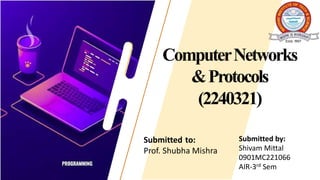
CNP proficiency.pptx
- 1. ComputerNetworks &Protocols (2240321) Submitted by: Shivam Mittal 0901MC221066 AIR-3rd Sem Submitted to: Prof. Shubha Mishra
- 2. 3 Table of contents 1. Fundamental Concept of Computer Networks: Network topologies 2. Terminologies of Computer Networks 3. Basic Taxonomy of Computer Networks: Computer network types 4. Network model: TCP/IP Model 5. IP Addressing 6. Routing Mechanisms
- 3. Network topologies Topology defines the structure of the network of how all the components are interconnected to each other. 1) Bus Topology: The bus topology is designed in such a way that all the stations are connected through a single cable known as a backbone cable. 2) Ring Topology: Ring topology is like a bus topology, but with connected ends. The node that receives the message from the previous computer will retransmit it to the next node. 3) Star Topology: Star topology is an arrangement of the network in which every node is connected to the central hub, switch or a central computer. The central computer is known as a server, and the peripheral devices attached to the server are known as clients. 4) Mesh topology: Mesh technology is an arrangement of the network in which computers are interconnected with each other through various redundant connections.
- 4. Terminologies of Computer Networks Network: A collection of interconnected devices, such as computers, printers, and servers, that can communicate with each other. Node: Any device connected to a network, such as a computer, printer, or router. Protocol: A set of rules and standards that define how devices on a network communicate with each other. IP Address: A unique numerical identifier assigned to each device on a network, used to identify and communicate with other devices. Router: A networking device that connects multiple networks together and forwards data packets between them. Switch: A networking device that connects devices on a network and forwards data packets between them. Firewall: A security device or software that monitors and controls incoming and outgoing network traffic, based on a set of predefined security rules. DNS (Domain Name System): A system that translates domain names (such as www.example.com) into IP addresses, allowing devices to locate and connect to websites and other network resources.
- 5. Computer Network Types A computer network can be categorized by their size. A computer network is mainly of four types : 1. Personal Area Network (PAN) - PAN is the most basic type of computer network. This network is restrained to a single person, that is, communication between the computer devices is centered only on an individual’s workspace. 2. Local Area Network (LAN) – LAN is the most frequently used network. A LAN is a computer network that connects computers through a common communication path, contained within a limited area, that is, locally. A LAN encompasses two or more computers connected over a server. 3. Metropolitan Area Network (MAN) - A MAN is larger than a LAN but smaller than a WAN. This is the type of computer network that connects computers over a geographical distance through a shared communication path over a city, town, or metropolitan area. 4. Wide Area Network (WAN) – WAN is a type of computer network that connects computers over a large geographical distance through a shared communication path. It is not restrained to a single location but extends over many locations.
- 6. Network Model: TCP/IP Model The TCP/IP model is the standard communication protocol for transmitting data over the internet. The TCP/IP (Transmission Control Protocol/Internet Protocol) model is widely used for communication on the internet and other computer networks. It consists of 4 layers: •Link Layer- The Link Layer deals with transmitting data over physical connections. •Internet Layer - The Internet Layer routes data packets between networks. •Transport Layer - The Transport Layer ensures reliable transmission of data.
- 7. IP addressing The address through which any computer communicates with our computer is simply called an Internet Protocol Address or IP address Types of IP Addresses : IPv4 - IPv4 address consists of two things that are the network address and the host address. It stands for Internet Protocol version four. IPv4 Address Format is a 32-bit Address that comprises binary digits separated by a dot (.). For Example, An IPv4 Address can be written as 189.123.123.90. IPv6 - IPv6 is based on IPv4 and stands for Internet Protocol version 6. IPv6 is written as a group of 8 hexadecimal numbers separated by colon (:). It can be written as 128 bits of 0s and 1s. IPv6 has some improved security which is built in with it. IPv6 offers security like Data Authentication, Data Encryption, etc. and IPv6 has increased and better support for Mobile Devices.
- 8. Routing The routing algorithms are used for routing the packets. The routing algorithm is nothing but a software responsible for deciding the optimal path through which packets can be transmitted. Types of Routing : Static Routing- • Static Routing is also known as Nonadaptive Routing. • It is a technique in which the administrator manually adds the routes in a routing table. • A Router can send the packets for the destination along the route defined by the administrator. Dynamic Routing- • It is also known as Adaptive Routing. • It is a technique in which a router adds a new route in the routing table for each packet in response to the changes in the condition or topology of the network. • Dynamic protocols are used to discover new routes to reach the destination. • All the routers must have the same dynamic routing protocol in order to exchange the routes
- 9. Thank you